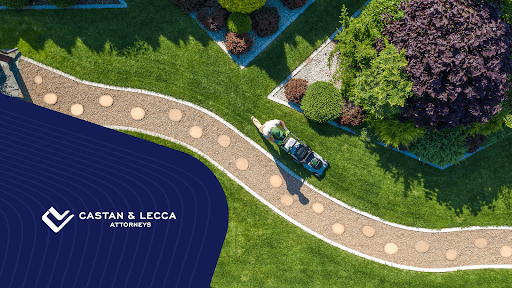
It’s summer, the time of year when most homeowners desire to fix up their lawns and try to become the belle of the ball in their neighborhood. This also means that these are the best months for the landscape industry, as they’re where the most gigs appear. However, more lawns to fix can also mean a spike in work injuries.
According to the Bureau of Labor Statistics, in 2019 there were 12,380 reported injury cases within the landscape industry. In a huge industry such as this one, with over 1 million employed and 604,163 landscaping businesses in the U.S.alone, workplace injuries must be prevented.
Therefore, in this blog article, you will learn what type of injuries you may face while landscaping, what are the most common hazards and how to avoid them, along with the rights you have as a worker in case you get injured on the job.
The most common landscaping injuries
Like in most manual labor jobs, landscape workers are exposed to suffer from work accidents. The most frequent on-the-job injuries you may face, without having the proper precaution to evade them, are:
- Cuts and amputations when cutting plants or using equipment, such as chainsaws and gardening shears.
- Fatigue from heat stress when working outdoors under the sun for long periods of time.
- Slips, trips, and falls from heights when working in trees.
- Overexposure to harmful chemicals from pesticides and other chemicals may result in toxic poisoning.
- Hearing loss from not using the proper protection while working with noisy equipment.
- Overexertion from lifting heavy equipment or using the incorrect technique.
- Repetitive stress injuries (RSIs) from incorrect postures or undergoing the same physical task over and over.
- Having a higher chance of electrocution from working in trees close to power lines, high voltage machinery, or faulty connections.
- Transportation-related injuries from debris falling off a moving vehicle or if a worker isn’t careful enough while driving.
Common landscaping hazards
According to the Occupational Safety and Health Administration (OSHA), landscape workers face a series of potential hazards while performing their jobs. The perils you should keep an eye out for and their possible solutions to avoid them at all costs are:
1) Soil preparation and grading: when landscape workers are preparing the soil by mixing soil conditioners (such as fertilizer) or moving soil to desired elevations, workers can either: get injured using their equipment, be hit by drivers moving equipment, or slip and trip in uneven landscapes. You can avoid these injuries by:
- Training and certifying operators and drivers with their equipment.
- Wearing protective personal equipment like boots with traction soles and ear protection.
- Staying clear of tiller blades.
2) Irrigation: when irrigation lines are being installed or undergoing maintenance, using materials, like PCV glue or other adhesives, without protection can cause irritated skin, eyes, nose, and throat. Also, being exposed to trenches and excavations may lead to amputations and electrocutions. To be protected from these injuries, you must:
- Wear protective gloves while manipulating adhesives.
- Steer clear of trencher blades.
- Inspect if your equipment works properly.
- Call 811 before you start digging.
3) Hardscape construction: while installing patios, decks, or even undergoing wood construction for clients’ lawns, not properly using a saw may lead to cuts and amputations. Even slips, trips, and lifting-related injuries can occur. The safety solutions you should take to avoid these hazards are:
- Proper training and use of saws.
- Wearing protective personal equipment such as ear protection.
- Ensuring that the equipment is safe to be used.
- Call 811 for any excavations.
4) Planting: when planting trees, shrubs, and grass for lawns, you’re not exempt to be injured while lifting objects, suffering from heat stress whilst planting, tripping, falling, or even from getting cuts and hand injuries like cramps when using tools. Take these proper precautions when planting:
- Get help to lift if needed.
- Stay hydrated and work in the shade if possible.
- Wear gloves while planting.
- Keep your job area clean of debris.
- Train and certify drivers.
5) Lawn and landscape maintenance: preserving a lawn with tasks like mowing, fertilizing, blowing, and even cleaning up may bring you hazards such as cuts, hand injuries, eye injuries, hearing loss, and chemical exposure. The safety measures you should follow while doing landscaping maintenance are:
- Wear gloves.
- Keep clear of rotating mower and brush-cutting blades.
- When using blowers, wear protective goggles.
- Maintain the mower’s settings to a comfortable and safe level to be used.
6) Tree care: when undergoing tree maintenance, whether it be pruning, chipping, or removing them, you are exposed to being in contact with power lines, getting hit by falling branches and tools, and tripping from heights. Avoid these hazards by:
- Using protective personal equipment such as hard hats, safety goggles, and ear protection while using a chainsaw.
- Knowing the drop zone of debris from trees.
- Properly attaching and securing a tree tie.
Knowing these hazards and their precautions can keep you and your coworkers safe. Thanks to OSHA’s standards, your employer is legally obligated to provide their workers with the proper personal protective equipment, protocols, and tools to avoid workplace accidents. As a worker, you have the right to make these demands to be safe while working and speaking up about these dangers without fear of retaliation.
Landscapers’ rights when injured
Fortunately, if you were to get injured on the job, as a landscaper, you have worker rights. One of these rights is getting medical attention right away. It is not necessary for you to file a claim and wait for it to be approved to get the proper care for your injuries. However, under Georgia state law, you must see a doctor or physician that is approved by your employer. The company must provide information about its approved doctors to all employees.
The other right you have is that you’re eligible for workers’ comp coverage. The first step that you’re required to do is to inform your employer and the employer’s insurance about the accident. If you don’t report within 30 days of your injury as stipulated by Georgia law, you may completely miss out on benefits.
In addition, you can also file a claim against your employer in the event your injuries were caused by their negligence to keep you safe, which can lead you to receive maximum compensation. Since Georgia has a no-fault workers’ comp system in place, you don’t need to prove that your injuries were caused because your employer was negligent. As long as the accident occurred during your work shift or by work activities, it’s enough to have a strong case.
Lastly, you also have the right to have an experienced workers’ comp attorney legally represent you. An attorney can help you apply and receive benefits such as:
- Temporary and permanent disability compensations: lost wages, coverage of medical costs, etc.
- The necessary medical care for your injuries.
- Vocational rehabilitation, in which due to your injuries, you will receive training or be educated for a new line of work.
Get the legal representation you need
If you’ve been injured in a landscaping accident, don’t wait any longer to start getting care. Here at Castan & Lecca, we are ready to help you with your paperwork, making sure your injuries are seen by a physician while gathering the amount of evidence you need to get the maximum compensation for your troubles.
Contact us to schedule a free consultation today to evaluate your case and
provide you with an accurate estimate of how much compensation is owed to you. Remember, you’re not alone. We are exceptional attorneys and we achieve superior results.












